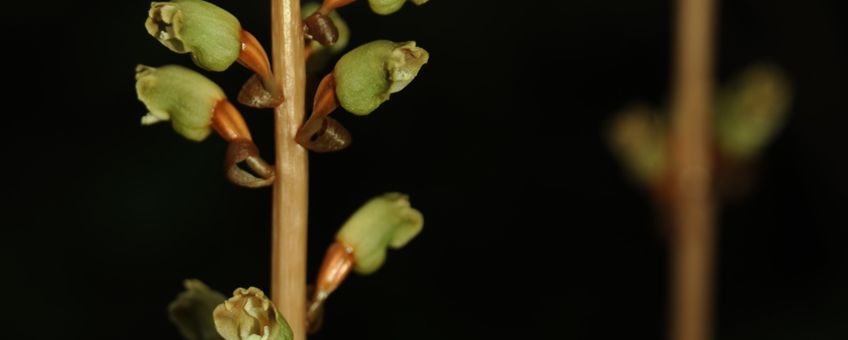
Cheating in the biological market: why and how orchids exploit on fungi
Naturalis Biodiversity CenterMimicking buyer-seller interactions in a human’s economic market, the majority of plants exchange goods with root-associated mycorrhizal fungi in a biological market, termed mycorrhizal symbiosis. In this symbiotic market, which has existed for 450 million years, plants trade photosynthetic carbon for essential nutrients (e.g., nitrogen and phosphorus) with mycorrhizal fungi. However, orchids break the rules of this mutual-benefit contract in the symbiotic market. They cheat on their fungal partners during a part or the entire length of their lives. Why and how the symbiotic mutualism breaks down within the orchid family poses an evolutionary mystery.
Mycoheterotrophy
All orchids obligately depend on mycorrhizal fungi to germinate their minute seeds, a strategy termed initial mycoheterotrophy. While most orchids become autotrophic green adults, some continue to exploit their fungal partners during their adult lives. Similar to holoparasitic plants, fully mycoheterotrophic orchids have a leafless/achlorophyllous appearance (see lead photo), and therefore they cannot perform photosynthesis. Fascinatingly, the loss of photosynthesis is replaced by living on particular mycorrhizal fungi, and in this way, fully mycoheterotrophic orchids manage to escape from the competition for light.
Partially mycoheterotrophic orchids can perform photosynthesis and simultaneously exploit mycorrhizal fungi in response to varying habitat conditions (e.g., light intensity). Therefore, the orchid family displays a continuum of nutritional mode, among which initial-/auto-trophy and full mycoheterotrophy are two endpoints. By evolutionary reconstructions, researchers at Naturalis Biodiversity Center and collaborators inferred at least seventeen independent shifts from autotrophy, via partial to full mycoheterotrophy in the orchid family. The detected shifts to mycoheterotrophy in Orchidaceae are spectacular because no other plant family displays such a high frequency of shifts in trophic modes.
![Illustration of the underground symbiotic networks between orchids and mycorrhizal fungi. [A] A leafy orchid preferentially receives nutrients from ‘rhizoctonia’ fungi. [B] A leafless orchid preferentially receives nutrients from ectomycorrhizal fungi (ECM) and wood- or litter-decaying saprotrophic fungi (SAP)](http://cdn-img.newstory.nl/naturetoday/images/optimized/4f7eab23-2024-4259-8aa5-1858db5dd001.jpg&w=770)
Partner choice
In past decades, molecular sequencing techniques have identified a wide range of fungal partners in orchids roots. In line with previous small-scale studies, our large-scale study highlights a general pattern of orchids’ partner preference. Autotrophic orchids tend to associate with ‘rhizoctonia’ fungi whereas mycoheterotrophic orchids tend to associate with ectomycorrhizal fungi (ECM) and saprotrophic decayers (SAP) in belowground hyphal networks.
The researchers' exhaustive hypothesis tests show that shifts in nutritional mode of orchids, from autotrophy to mycoheterotrophy, are often accompanied by shifts in fungal partners. Thus, shifts in fungal partners gradually promote the evolution of mycoheterotrophy and lead to the loss of photosynthesis. Why do mycoheterotrophic orchids select particular fungal partners? One appealing hypothesis is that ectomycorrhizal fungi linking with trees and saprotrophic fungi decaying wood debris and leaf litters can provide a more beneficial carbon supply for nearby mycoheterotrophic orchids that deficit in photosynthesis in shady forests.
More information
- Curious about further details of this study? Read the full publication in New Phytologist.
Text: Deyi Wang and Vincent Merckx, Naturalis Biodiversity Center
Photos: Deyi Wang (lead photo: the leafless Gastodia elata, a fully mycoheterotrophic orchid)
